Basic AI Chatbot Pricing: A simple chatbot that can answer questions about a product or service might cost around $10,000 to develop.
Read More

Ever wondered what it would be like to give your clients a chance to “walk through” their dream home from the comfort of their couch? Well, it’s no longer a futuristic fantasy.
According to reports, the AR market is expected to reach $599 billion by 2030.
That’s right, billions being pumped into the future of home buying and selling, and if you’re not using AI & AR home visualization mobile application development, you might just be missing the party.
Imagine your potential buyers scrolling through their phones, exploring 3D property tours, adjusting walls, moving furniture, and getting personalized home recommendations, all without ever stepping foot in the house.
It’s not science fiction; it’s the new reality of real estate.
AI-powered AR property visualization apps are transforming the way homes are bought, sold, and marketed. From realtors to interior designers, everyone’s jumping on this trend, enhancing the buyer experience while speeding up the sales process.
But wait, what about you? Are you already on board, or are you letting the competition leave you in the dust?
In this guide, we’ll take a deep dive into how real estate agencies can build AI & AR mobile apps for home visualization, giving you all the tools you need to stay ahead.
Let’s go.
If you're still picturing AI as a futuristic robot or AR as just fancy Snapchat filters, it's time to recalibrate.
Let’s break it down, shall we?
AI in real estate isn’t just about making your app “smart” (though that’s a nice perk!). Here’s how it proves invaluable:
Once you try it out, you’ll wonder how you ever did business without it.
AR in real estate is the magician behind virtual home tours. Here’s how:
In short, it’s the closest thing to having a magic wand for home buying.
Together, AI and AR aren’t just a power duo, they're a dream team, taking your real estate business from ordinary to extraordinary. And with more people shifting online for their home-buying journeys, it’s about time you offered a tool that stands out in the crowded marketplace.
Also read: Role of AI in Real Estate Development
When building an AI & AR home visualization app, it’s important to tailor the features to the needs of real estate professionals and their clients.
Here's what’s really needed to create an app that makes the property-buying process more engaging, efficient, and enjoyable for all parties involved:
| Feature | Benefit to Real Estate Professionals |
|---|---|
|
Personalized Property Recommendations |
By presenting the right properties, buyers are more likely to schedule viewings or make offers. |
|
Virtual Property Tours |
Attract more international or long-distance buyers and save time for both agents and clients by reducing unnecessary visits. |
|
3D Floor Plan Interactivity |
Buyers get a clearer idea of space layout and functionality before even stepping inside the property. |
|
Augmented Home Staging |
Buyers can see potential changes without needing to imagine them. It helps them feel more confident in their choices. |
|
AI-Powered Valuations & Comparisons |
Helps real estate agents set competitive prices and allows buyers to make informed offers based on real data. |
|
Time-of-Day Visualization |
Clients can see how the home feels at different times, helping them make more informed decisions, especially for properties with varied lighting. |
|
Interactive Neighborhood Insights |
Agents can offer valuable neighborhood context that helps clients evaluate their lifestyle options based on location, not just the property. |
|
Lead Tracking & AI Chatbots |
AI handles initial inquiries and follow-ups, allowing agents to focus on high-value interactions, resulting in better lead management and faster responses. |
These features, designed with an AI app development company, ensure that the AI & AR home visualization mobile application is not only cutting-edge but also practical and user-centric.
So, you've got the basics down, but what if you could take your AI & AR home visualization mobile application to the next level?
With a few advanced features, you can provide an even more immersive, intuitive, and personalized experience that keeps clients coming back for more.
Let’s dive into some advanced features that can truly elevate your app from good to great:
Imagine combining real-world views with virtual elements for a fully immersive experience.
Mixed Reality (MR) lets users interact with properties in a way that feels almost real, merging the physical and digital worlds seamlessly.
This feature increases client engagement and offers a truly interactive experience.
Let users control their virtual tours or AR experiences through voice commands.
This hands-free feature provides a seamless and accessible experience for users, allowing them to navigate property tours without lifting a finger.
It's convenience at its finest!
Imagine the power of agents and clients collaborating live within the app. They can discuss properties, share thoughts, and even modify virtual tours together in real-time.
This feature makes the process smoother, enhancing collaboration and strengthening relationships between agents and buyers.
With AI, you’re not just suggesting properties, you’re predicting future property values and market trends.
By offering insights into which investments will likely provide the best returns, you’re equipping both clients and agents with data-driven tools to make smarter decisions. To ensure seamless integration of AI analytics, consider AI integration services for your app.
Buyers want to see potential, and virtual staging lets them do just that. They can experiment with different staging options, including furniture placements, wall colors, and decor styles, all in real-time.
This helps them envision the space as their own, making them more likely to make an offer.
For clients with a vision for change, AR home renovation simulation is a game-changer. It allows them to virtually knock down walls, add rooms, or upgrade furniture, all within the app.
This helps them make more confident decisions about purchasing or renovating a property.
An often-overlooked feature, mortgage and financing tools help users calculate estimated rates, monthly payments, and even get pre-approved for loans directly in the app.
It streamlines the buying process, making it easier for clients to take the next step toward owning their dream home.
These features not only increase engagement but also provide real value that sets your AI & AR home visualization mobile application apart from the competition.
Also read: AI and Augmented Reality: Transforming the Online Shopping Experience
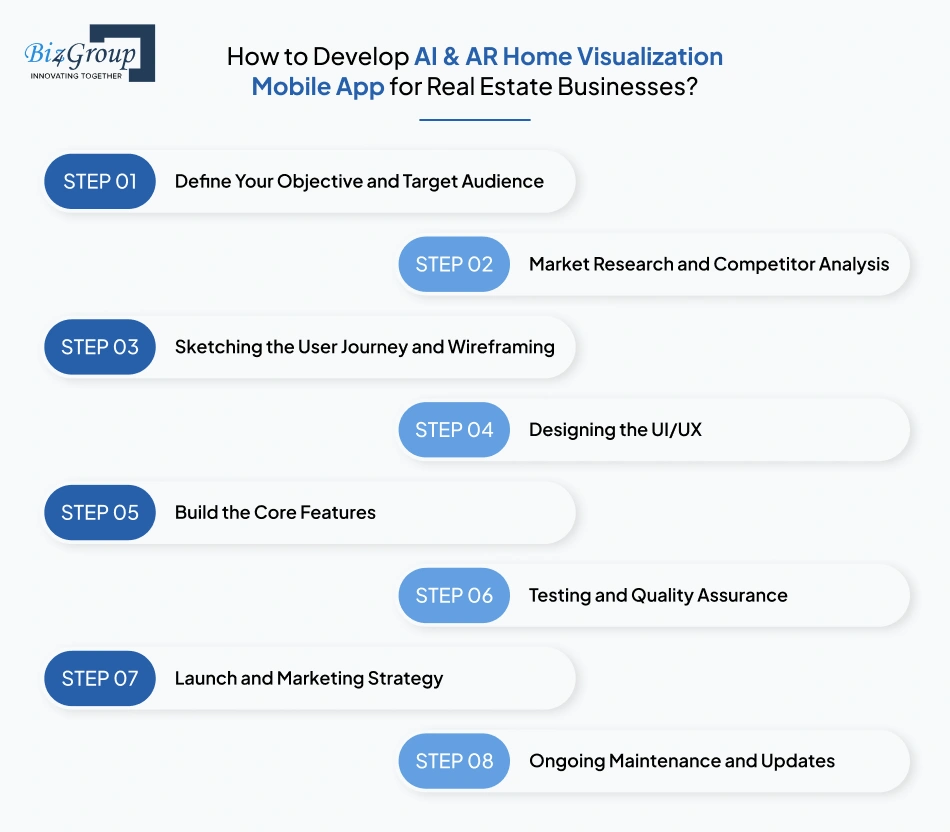
When it comes to developing an AI & AR home visualization mobile application, the process can be complex but breaking it down into clear steps will help you navigate through it.
Here are the key steps you need to take to develop a top-tier AI & AR home visualization mobile app for the real estate market:
Before you dive into the code:
Defining this upfront ensures that your app will meet the needs of its users and has clear value from day one.
Research similar AI & AR home visualization mobile apps and evaluate their strengths and weaknesses.
Understanding your competitors is essential in ensuring your app stands out.
Wireframes are a great way to visualize the app’s flow and ensure it’s intuitive for users.
This step helps establish how users interact with the app and ensures seamless navigation.
Focus on creating an engaging, easy-to-navigate design that keeps users coming back (or partner with a UI/UX design company).
Also Read: Top 15 UI/UX Design Companies in USA
This phase focuses on building out the main features and functionality.
By now, your app should begin to take shape with core functionalities.
QA is crucial, especially with AI & AR features, as these technologies need to work smoothly across different devices and environments.
This phase guarantees that the app provides a seamless, error-free experience.
Launch day doesn’t mean just hitting “publish.” You need a strategic approach to make waves in the market.
This step sets the stage for your app’s success and ensures it reaches the right audience.
Wait for valuable feedback that can help improve it.
Keeping your app fresh and up-to-date is essential for retaining users and staying competitive.
AI & AR home visualization mobile application development is a dynamic, ongoing process that involves a combination of creativity, technology, and user-focused thinking. By following these steps, you can build an app that meets the needs of today’s real estate market.
Also read: How to Develop Real Estate Mobile App?
Let's build the next big thing in real estate tech together!
Build with Biz4GroupWhen developing an AI & AR home visualization mobile application, selecting the right tools and technologies is crucial to building a high-performance, scalable, and feature-rich app.
Here’s a comprehensive breakdown:
| Tool/Technology | Description | Why It's Essential |
|---|---|---|
|
ARKit (iOS) |
Apple's AR framework for building AR experiences on iOS devices. |
Enables high-quality AR experiences, supporting 3D models, real-world interaction. |
|
ARCore (Android) |
Google’s AR framework for creating augmented reality apps on Android. |
Provides real-time tracking, depth sensing, and AR experiences on Android devices. |
|
Vuforia |
A cross-platform AR framework supporting both iOS and Android. |
Robust AR platform for object recognition, tracking, and 3D model rendering. |
|
Unity 3D |
Game engine supporting AR development, especially with ARKit and ARCore. |
Powerful for integrating complex 3D models and simulations, enhancing AR experiences. |
| Tool/Technology | Description | Why It's Essential |
|---|---|---|
|
TensorFlow |
Open-source library for building machine learning models. |
Used for implementing AI models like property recommendation and predictive analytics. |
|
PyTorch |
Open-source deep learning framework. |
Powerful for natural language processing (NLP), machine vision, and predictive models. |
|
Scikit-learn |
Python library for simple and efficient machine learning algorithms. |
Ideal for building recommendation systems and property valuation models. |
|
OpenCV |
Computer vision library for processing images and video. |
Essential for recognizing objects and features in AR environments and images. |
| Tool/Technology | Description | Why It's Essential |
|---|---|---|
|
JavaScript runtime environment for building fast, scalable server-side apps. |
Used to create efficient backends that can handle real-time interactions and data processing for AR and AI. |
|
|
Programming language widely used in data science and AI. |
Flexible and popular for implementing AI models, backend APIs, and complex data processing. |
|
|
Firebase |
Backend-as-a-Service (BaaS) for mobile and web apps, providing real-time databases. |
Real-time data synchronization, easy to scale, and built-in authentication and storage. |
|
MongoDB |
NoSQL database for storing large amounts of unstructured data. |
Ideal for storing dynamic data like user profiles, preferences, and AR content. |
|
PostgreSQL |
Open-source SQL database for relational data. |
Helps with handling complex queries, ensuring structured data is managed effectively. |
| Tool/Technology | Description | Why It's Essential |
|---|---|---|
|
React Native |
Framework for building cross-platform apps using JavaScript and React. |
Allows you to build mobile apps for both iOS and Android with a shared codebase, saving time and cost. |
|
Flutter |
UI toolkit for building natively compiled applications for mobile, web, and desktop. |
Ensures high-performance apps with smooth UI, essential for rendering complex AR visualizations. |
|
Swift |
Programming language for iOS development. |
Required for building seamless, high-performance iOS apps, especially for ARKit integration. |
|
Kotlin |
Language for building Android applications. |
Used for developing fast, native Android apps that integrate well with ARCore. |
| Tool/Technology | Description | Why It's Essential |
|---|---|---|
|
AWS (Amazon Web Services) |
Cloud services providing storage, computing power, and analytics. |
Scalable and reliable cloud infrastructure to support large-scale apps with real-time data needs. |
|
Google Cloud Platform (GCP) |
Cloud services for hosting and processing data. |
Offers robust AI and machine learning capabilities that integrate easily with your app. |
|
Microsoft Azure |
Cloud computing services offering machine learning and data analytics tools. |
Great for building, deploying, and managing AI models and AR applications at scale. |
| Tool/Technology | Description | Why It's Essential |
|---|---|---|
|
Figma |
Cloud-based design tool for UI/UX design. |
Ideal for collaborative design and prototyping, ensuring user-friendly app interfaces. |
|
Sketch |
Vector graphics editor for creating user interfaces. |
Powerful for creating high-quality app designs and user flows. |
|
Adobe XD |
Design and prototyping tool for web and mobile apps. |
Allows fast and responsive prototyping, perfect for AR/AI-based design experimentation. |
By integrating the right tools and technologies, you’ll be able to build an AI & AR home visualization mobile application that’s both powerful and scalable.
These technologies work together to create a seamless, immersive experience that engages users, enhances decision-making, and simplifies the property buying and selling process.
Also read: How to Build Real Estate AI Software?
When it comes to developing AI & AR home visualization mobile applications, security and regulatory compliance should be top priorities.
Here’s what you need to know to ensure your app meets security and compliance standards.
With the vast amount of personal data your app will handle, privacy is key.
Protecting user accounts and ensuring that only authorized users can access their data is crucial.
Depending on the market you're targeting, your app may need to comply with various industry standards and regulations.
Regular audits and testing are essential to detect and prevent vulnerabilities.
Incorporating AR into your app opens up unique legal challenges related to content usage and intellectual property.
Your app will likely rely on third-party services for AI algorithms, cloud storage, and payment processing.
For apps that rely on cloud services for storing and processing data, security measures must be robust.
Ensuring security and compliance in your AI & AR home visualization mobile application is a responsibility to protect your users and maintain their trust.
Up next, let’s take a closer look at the cost breakdown for developing such an app.
When it comes to developing an AI-powered AR property visualization app, the investment can vary significantly depending on the complexity of the features, the development approach, and the scale of the app.
On average, the cost to develop such an app ranges from $50,000 to $300,000+, with the price fluctuating based on different factors and the development phases.
Read on...
Several elements affect the overall cost of your AI-powered AR property visualization app. These factors can significantly impact the final pricing, and here's what you should consider:
MVP (Minimum Viable Product): The basic version of the app with essential features like AR-based property tours, basic AI recommendations, and limited backend support.
Cost: $50,000 - $80,000.
Advanced Level: More sophisticated features like predictive analytics, real-time collaboration, and full AR customization options.
Cost: $100,000 - $150,000.
Enterprise-Level: Highly scalable, secure, and feature-rich app with AI-powered property valuations, advanced analytics, and integration with third-party services.
Cost: $200,000 - $300,000+.
Also read: Building an AI Real Estate App MVP
Developing apps for both iOS and Android will increase costs as you need to build and maintain two separate codebases, especially if not using cross-platform frameworks.
Cost increase: 15-25%.
The complexity of AR features like 3D models, virtual staging, and real-time property visualizations can add significant cost. High-level AR features require more development and testing time.
Cost increase: 15-30%.
Simple AI features like property recommendations based on basic algorithms are cheaper than advanced AI functionalities like predictive analytics and real-time market trend analysis.
Cost increase for advanced AI: 20-35%.
The more advanced and interactive the design, the higher the cost. A user-friendly and immersive UI/UX, especially for AR interactions, requires more skilled designers and time.
Cost increase: 10-20%.
Apps with high data processing demands (like AI and AR features) need strong server infrastructure. The more sophisticated the backend (with real-time data processing), the higher the cost.
Cost increase: 10-20%.
Integration with external services such as payment gateways, real estate databases, or cloud services can increase the overall development cost.
Cost increase: 5-15%.
Here’s an estimate of the costs based on the different phases of app development:
| Phase | Estimated Cost | Description |
|---|---|---|
|
Planning & Design |
$10,000 - $30,000 |
Market research, wireframing, design prototypes, and finalizing features. |
|
Core Development |
$30,000 - $100,000 |
Building core app features like AR functionality, initial AI models, property recommendations, and backend integration. |
|
Testing & Launch |
$10,000 - $20,000 |
Covers quality assurance, bug fixes, deployment to app stores, and initial marketing campaigns. |
|
Post-Launch Support |
$5,000 - $15,000 annually |
Ongoing support and updates. |
|
Marketing & User Acquisition |
$5,000 - $30,000 |
Costs for marketing to boost app visibility. |
The total cost will depend on the features and complexity you choose, with advanced-level apps pushing costs toward the higher end of these ranges.
While the above factors give a broad estimate, there are often additional, hidden costs involved in app development. These costs can quickly add up, so here’s what to keep in mind:
Even after launch, you'll need to maintain your app, fix bugs, and update features as technology advances.
Maintenance typically costs around 15-20% of the initial development cost annually.
Storing and processing large amounts of data, especially for AI and AR features, requires cloud hosting.
Depending on your app’s scale and user base, this can cost between $5,000 - $15,000 per year for mid-level usage.
AR and AI frameworks often come with licensing fees. For example, using ARKit or ARCore might have associated costs, while custom AI models will need to be trained and maintained, adding to the cost.
License fees: $2,000 - $10,000.
Integrating third-party services (like payment gateways, APIs, or external databases) usually incurs additional charges.
Expect to pay $1,000 - $5,000 annually for API access and integrations.
Building the app is only half the battle; getting users is where the real cost kicks in. Marketing campaigns, app store optimization (ASO), and influencer partnerships can cost anywhere from $5,000 - $30,000 for initial user acquisition.
You’ll need legal services to ensure compliance with privacy laws, intellectual property rights, and general terms of service.
This can cost $3,000 - $10,000 depending on the complexity and market.
After the app is launched, continual testing for bugs and security vulnerabilities is essential.
This can run you anywhere from $5,000 - $15,000 annually.
If you're integrating complex features like AI or advanced AR, your team may need ongoing training. Plus, you'll need customer support to handle queries.
Budget for $3,000 - $8,000 annually.
This cost breakdown should give you a clear understanding of what to expect in terms of investment when building your AI-powered AR property visualization app.
Find out we can build your dream app without breaking the bank.
Get Your Cost Estimate
Developing an AI & AR home visualization mobile application involves significant investment, but that doesn’t mean you have to break the bank.
There are smart strategies and tactics you can apply throughout the development process to optimize costs while still building a high-quality, feature-rich app.
Let’s explore some of those strategies.
Begin with an MVP that focuses on the most essential features.
This allows you to launch faster, get user feedback, and make improvements in later versions without overcommitting financially upfront.
Estimated Cost Savings: 20-30% by focusing on core features initially.
Also read: Top 12+ MVP Development Companies in USA
Building separate apps for iOS and Android can be costly. Using frameworks like React Native or Flutter allows you to build one app that works across both platforms, saving on development time and costs.
Estimated Cost Savings: 15-25% on development costs.
Use open-source libraries and tools for certain features like AI models or AR frameworks.
This can significantly reduce both time and development costs.
Estimated Cost Savings: 10-15% on licensing fees and development time.
Focus on the most impactful ones that directly serve your target audience.
Start simple and scale up as needed, rather than integrating every possible advanced function in the first version.
Estimated Cost Savings: 15-30% by avoiding overcomplicating initial features.
Opt for flexible, scalable cloud services like AWS or Google Cloud, which let you scale as your user base grows, instead of committing to expensive infrastructure early on.
Estimated Cost Savings: 10-20% on infrastructure costs.
Outsourcing certain parts of the app development, like UI/UX design or backend integration, to specialized developers or agencies can be more cost-effective than having a full in-house team handle everything.
Estimated Cost Savings: 10-20% on staffing and development time.
Focus on improving the user experience post-launch.
Regular updates, bug fixes, and engaging features will keep your existing user base happy, which can save on marketing and acquisition costs.
Estimated Cost Savings: 5-15% on ongoing marketing efforts.
Keep track of your budget and expenses throughout the development process.
Estimated Cost Savings: 5-10% on unplanned overruns.
By following these strategies, you can optimize your costs while still delivering an impressive AI & AR home visualization mobile application.
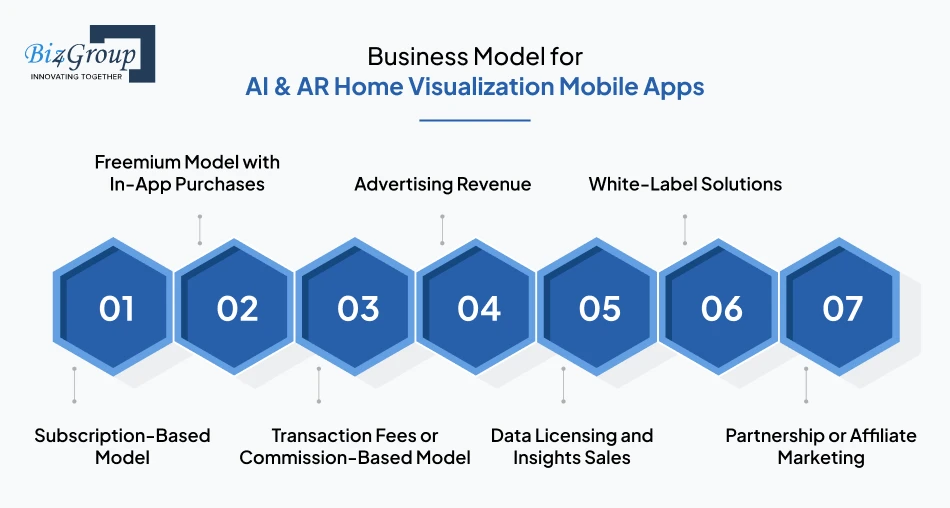
Building an AI & AR home visualization mobile application is about building a sustainable business model. These apps can generate income through various channels, offering flexibility for developers, agencies, and real estate professionals to find the best approach for their market.
Here are the most common and effective ways AI & AR home visualization apps generate revenue:
This model works well for apps that offer premium services or advanced features like AI-driven property recommendations, AR-based home tours, or personalized home staging.
Estimated Revenue:
The freemium model allows users to download and use the app for free, with basic features. To access premium content or advanced functionalities, users are encouraged to purchase in-app upgrades or features.
This model is particularly effective for real estate apps that facilitate buying, selling, or renting properties directly through the platform.
How It Works:
Revenue Example:
In-app advertising is another effective way to generate revenue, especially if the app has a large user base. Advertisers (e.g., mortgage lenders, property developers, or home improvement companies) pay to display ads within the app.
Apps can license property data or market insights to third parties, such as real estate investors, marketing firms, or market analysts.
How It Works:
It involves offering the app's technology to other real estate businesses to rebrand and use as their own.
How It Works:
How It Works:
This model works well where partnerships with related services (like home loans or home improvement) are common. The key is ensuring that the partnerships align with user needs and offer real value.
By combining multiple income channels, your app can remain profitable while providing real value to users.
Also read: How to Integrate Augmented Reality with AI in Home Renovation Design?
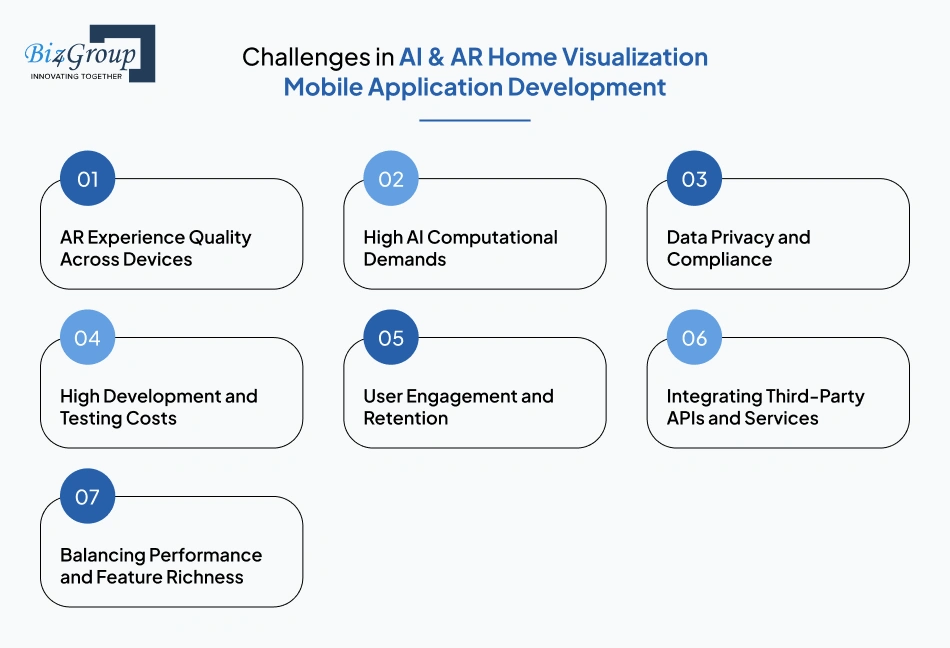
Developing an AI & AR home visualization mobile application is no small feat.
Along the way, developers and stakeholders will encounter several challenges.
However, with the right strategies in place, each of these obstacles can be addressed effectively, ensuring a smooth development process and a successful final product.
Let's explore some common challenges and the solutions to overcome them.
Ensuring that AR features like virtual property tours and 3D visualizations work seamlessly across a wide range of devices can be tricky.
Solution:
Additional testing and optimization could increase costs by 10-20%.
AI models that power property recommendations, market trend analysis, and predictive analytics require substantial computational power and data processing.
Solution:
Cloud services and infrastructure management may increase costs by 10-20% annually.
Managing and protecting user data is critical. Regulations like GDPR and CCPA add complexity to compliance requirements.
Solution:
Legal consultations and implementation could add $3,000 - $10,000.
Building AI & AR features often requires specialized skills, such as machine learning, computer vision, and AR development, which can drive up costs.
Solution:
Using automated testing tools can save 10-15% of testing-related expenses.
Users may get excited about the initial features, but if the app doesn’t provide continuous value or offer new experiences, retention rates can drop.
Solution:
Ongoing engagement efforts can add 5-10% of the initial development cost.
Integrating third-party services like payment gateways, property databases, or cloud services can cause compatibility issues and lead to additional costs for ongoing support and updates.
Solution:
Maintenance of third-party integrations could cost $1,000 - $5,000 annually.
The more features you add to an app, the more resources it requires.
Solution:
Performance optimizations could add 10-15% to the development cost.
By incorporating these best practices and avoiding common mistakes, you'll be able to build a successful, scalable, and secure AI & AR home visualization mobile application that provides a seamless user experience and meets business objectives.
Also read: Augmented Reality Development and Its Challenges
The world of AI & AR home visualization mobile applications is constantly evolving, with new technologies, features, and opportunities emerging every year.
Here’s a look at some of the future trends that will shape the development of AI & AR in real estate home visualization over the next few years.
Mixed Reality (MR) combines both Augmented Reality (AR) and Virtual Reality (VR), allowing users to interact with a fully immersive environment that blends the real and virtual worlds seamlessly. This will allow clients to view properties and make decisions in fully interactive, life-like environments.
Predictive analytics, powered by AI, will provide real-time market trends, investment predictions, and pricing forecasts based on historical data, market conditions, and consumer behavior.
As AI becomes more sophisticated, it will enable even greater personalization, with algorithms that better understand buyer preferences, making more accurate suggestions based on personal tastes, budget, and behavioral data.
Virtual staging and home renovation simulations, powered by AI, will allow users to virtually redesign properties, choose new furniture, change paint colors, or even add rooms, all within the app.
With the rise of voice assistants and visual search technologies, buyers will increasingly rely on voice or image-based searches to find homes that match their preferences.
As 5G technology continues to roll out globally, it will enable faster, more reliable real-time virtual tours and live 3D property walkthroughs.
Blockchain technology will play a more significant role in the real estate market, especially when it comes to transactions and contract management. Smart contracts can automate and securely execute agreements.
AI-powered virtual home assistants will become commonplace, helping both buyers and real estate agents navigate the property market with ease.
The future of AI & AR in real estate is nothing short of exciting. With AI powering personalization, predictive analytics, and virtual staging, combined with AR providing immersive property tours and real-time visualization, the landscape of home buying and selling is set for major transformation.
With these trends, your AI & AR home visualization mobile application is poised to lead the charge in providing the best user experience possible.
At Biz4Group, we are more than just a real estate AI software development company, we are your trusted advisors in the journey of transforming ideas into real-world solutions.
With us, you won’t just be hiring AI developers, you get experts building innovative AI and AR-driven applications tailored for businesses looking to make a significant impact in their industry.
Our mission is simple: to empower businesses with technology that helps them grow, adapt, and thrive.
As an AI development company, we understand that building software isn’t just about code; it’s about understanding the challenges of your industry and delivering solutions that create real value.
At Biz4Group, along with building apps, we build relationships. Our team of developers, designers, and strategists are dedicated to making sure you achieve your business goals with cutting-edge technologies that drive results.
Here’s why companies choose us:
With years of experience in AI, AR, and software development, we have the technical knowledge and business acumen to turn your vision into reality.
We understand that each business is unique, which is why we offer custom-built solutions that align with your specific goals, industry, and audience.
We are always on the lookout for emerging technologies and innovative solutions that can help our clients gain a competitive edge in their markets.
We believe in building strong, transparent partnerships with our clients, involving you every step of the way in the development process.
Our work doesn’t end at launch. We provide ongoing support to ensure your app stays updated and performs optimally as your business grows.
As a trusted advisor, we ensure that every project we undertake is secure, compliant with industry standards, and data-privacy-focused, so you can rest easy knowing your solution is built on solid foundations.
We have successfully delivered several real estate-specific solutions that have empowered businesses with smarter, more efficient ways to handle property management, contract tracking, and home visualization.
Here are some of our standout projects:
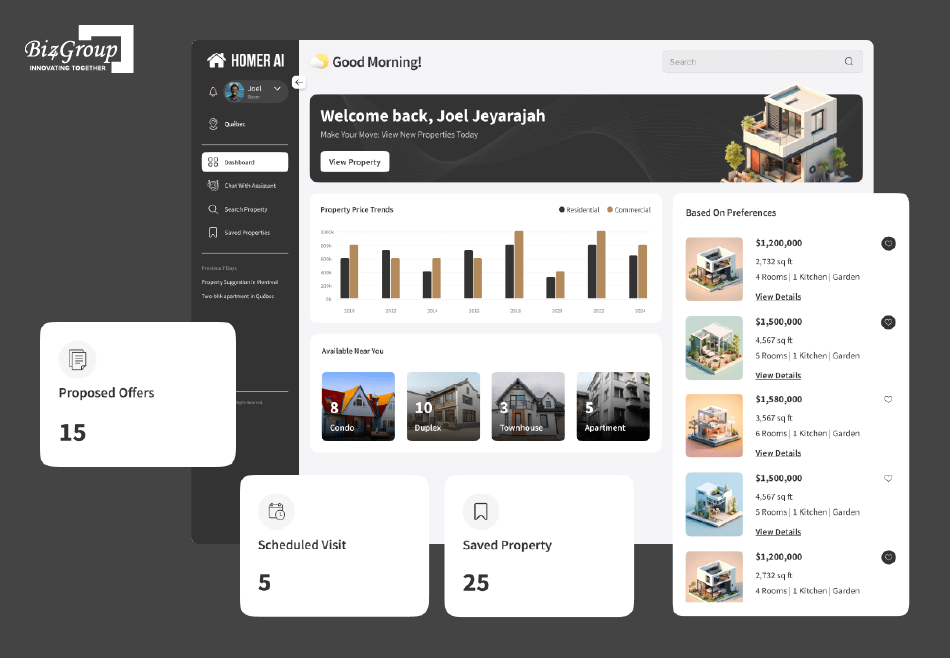
Homer AI is an AI-based modern property management application that connects buyers and sellers, providing an end-to-end service. From understanding the buyer’s preferences to scheduling property visits, Homer AI uses conversational AI to guide buyers through their journey and helps sellers efficiently list their properties.
Key Features:
Homer AI helps make the property-buying process more efficient, interactive, and personalized, reducing human intervention while providing a seamless experience for both parties.
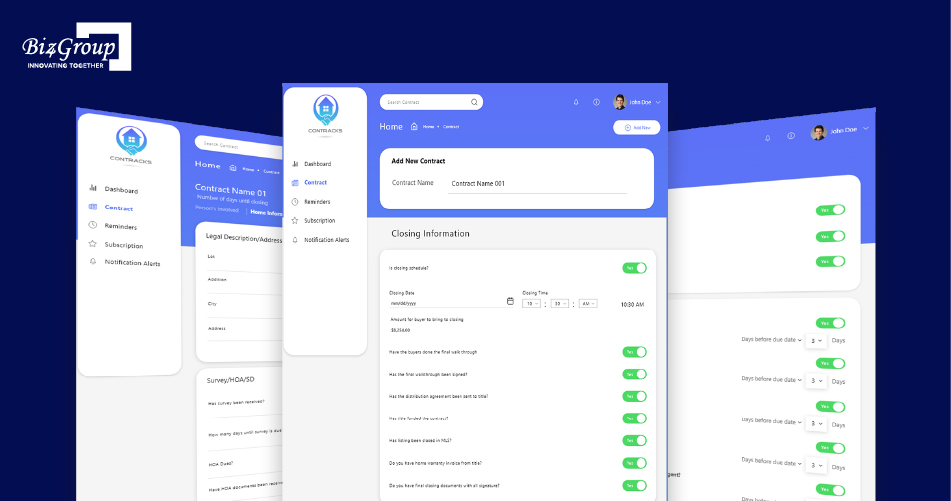
Contracks is a real estate contract management tool designed to streamline contract workflows for agents, brokers, and property managers. By integrating AI for automated document summarization and intelligent content extraction, it simplifies the creation, tracking, and management of contracts.
Key Features:
Contracks empowers real estate professionals by automating time-consuming tasks, freeing them to focus on what matters most, closing deals and building client relationships.
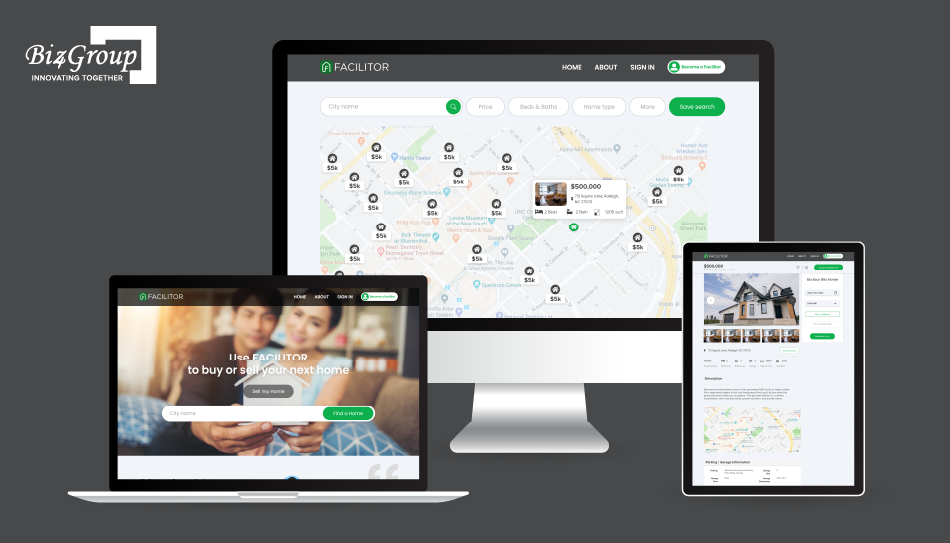
Facilitor is an AI-powered real estate platform aimed at addressing challenges like remote property visits, buyer-seller communication gaps, and post-purchase financial issues. It integrates AI to recommend properties based on budget and location and provides a realtor service for safer property visits.
Key Features:
Facilitor bridges the gap between buyers and sellers by providing a safe, transparent, and efficient experience for all parties involved.
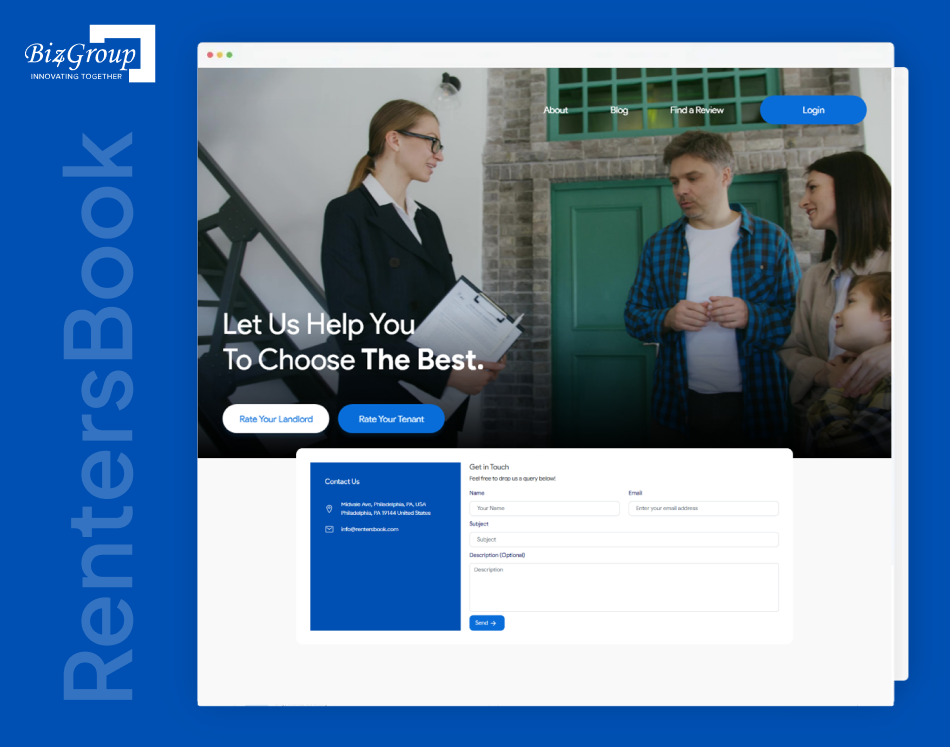
Renters Book is a review and ratings platform that helps tenants and landlords make informed decisions before entering a rental agreement. By compiling verified reviews for both parties, it offers an extra layer of trust and transparency in the rental process.
Key Features:
Renters Book takes the uncertainty out of renting by giving tenants and landlords the opportunity to evaluate each other based on verified reviews, ensuring a smoother, more reliable rental process.
Our track record in the real estate sector speaks for itself, and we’re ready to help you revolutionize the way people experience property buying, selling, and management.
Let’s turn your idea into an innovative solution that not only meets the demands of today’s market but sets you apart as a leader in the real estate industry.
Together, let’s make it happen!
And there you have it, AI & AR home visualization mobile applications are transforming the real estate landscape, turning the traditional buying and selling process into an immersive, data-driven experience.
The future is here, and it's not just about flashy features; it's about creating meaningful experiences for buyers, sellers, and agents alike.
At Biz4Group, we’ve been at the forefront of this revolution, crafting AI-powered and AR-driven solutions that empower businesses to step into the future with confidence.
With our expertise, as a real estate website development company, we help you lead the charge in reshaping the way properties are bought, sold, and experienced.
From personalized property recommendations to virtual home tours and seamless transactions, we’re here to make sure you’re not just keeping up with the competition, you’re outpacing it. The future of real estate is digital, immersive, and incredibly smart, and Biz4Group is the perfect partner to help you navigate this exciting journey.
So, what are you waiting for? Let’s build the next big thing together because the future of real estate is calling, and we’ve got the tools to answer it!
AI and AR can revolutionize the real estate buying experience by providing personalized property recommendations, virtual tours, and real-time market insights. With AR, buyers can walk through homes virtually, view 3D floor plans, and even stage homes digitally. AI adds value by predicting property trends and offering data-driven investment insights, helping buyers make smarter decisions.
Yes, AI and AR features can be integrated with existing real estate websites and platforms. For example, you can integrate AI for property recommendations and AR for virtual tours, providing a richer user experience without overhauling the entire platform. APIs and other integration tools can be used to connect these advanced features to your current website infrastructure.
AI and AR are essential for remote buyers, allowing them to view properties virtually from anywhere in the world. AR enables immersive, interactive property tours, while AI offers personalized recommendations based on preferences, such as location, price, and features. These technologies make it easier for buyers to make informed decisions without needing to visit the property in person.
The return on investment (ROI) for investing in an AI & AR mobile app can be significant. With features like virtual tours, AI-driven recommendations, and real-time market insights, businesses can attract more clients, increase conversions, and improve customer satisfaction. The app can also reduce operational costs, speed up transactions, and increase overall sales, leading to better profitability.
To ensure your app stands out, focus on providing a unique user experience with advanced AI-powered personalization and seamless AR features that go beyond standard property tours. Offering real-time collaboration between buyers and agents, integrating predictive analytics, and maintaining a user-friendly interface will keep your app ahead of the competition. Regular updates, feature expansions, and customization options will also help retain users and keep the app relevant in a fast-evolving market.
with Biz4Group today!
Our website require some cookies to function properly. Read our privacy policy to know more.